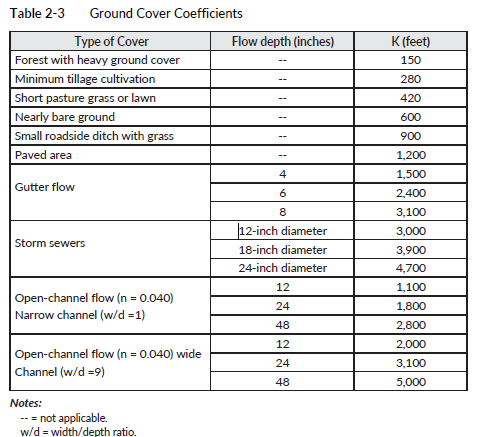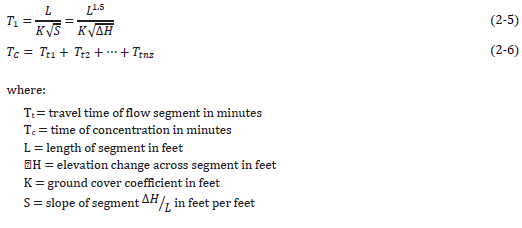 Time of concentration (Tc) is defined as the time for runoff to travel from the hydraulically most distant point of the watershed to a point of interest in the watershed. Travel time (Tt) is the time water takes to travel from one location to another in a watershed. Tt is a component of Tc, which is computed by summing all the travel times for consecutive components of the drainage flow path. This concept assumes that rainfall is applied at a constant rate over a drainage basin, which would eventually produce a constant peak rate of runoff.
Time of concentration (Tc) is defined as the time for runoff to travel from the hydraulically most distant point of the watershed to a point of interest in the watershed. Travel time (Tt) is the time water takes to travel from one location to another in a watershed. Tt is a component of Tc, which is computed by summing all the travel times for consecutive components of the drainage flow path. This concept assumes that rainfall is applied at a constant rate over a drainage basin, which would eventually produce a constant peak rate of runoff.
Actual precipitation does not fall at a constant rate. A precipitation event usually begins with less rainfall intensity, builds to peak intensity, and eventually tapers down to no rainfall. Because rainfall intensity is variable, the time of concentration is included in the Rational Method so that the PEO can determine the proper rainfall intensity to apply across the basin. The intensity that should be used for designing is the highest intensity that will occur with the entire basin contributing flow to the flow rate location being studied. This may be a much lower intensity than the maximum intensity because of it taking several minutes before the entire basin is contributing flow; the maximum intensity lasts for a much shorter time, so the rainfall intensity that creates the greatest runoff is less than the maximum by the time the entire basin is contributing flow.
Most drainage basins consist of different types of ground covers and conveyance systems that flow must navigate. These are referred to as flow segments. It is common for a basin to have overland and open-channel flow segments. Urban drainage basins often have flow segments that flow through a storm sewer pipe in addition to overland and open-channel flow segments. A travel time (the amount of time required for flow to move through a flow segment) must be computed for each flow segment. The time of concentration is equal to the sum of all the flow segment travel times.
For a few drainage areas, a unique situation occurs where the time of concentration that produces the largest amount of runoff is less than the time of concentration for the entire basin. This can occur when two or more subbasins have dramatically different types of cover (i.e., different runoff coefficients). The most common case would be a large, paved area together with a long, narrow strip of natural area. In this case, the PEO shall check the runoff produced by the paved area alone to determine if this scenario would cause a greater peak runoff rate than the peak runoff rate produced when both land segments are contributing flow based on a shorter time of concentration for the pavement-only area. The scenario that produces the greatest runoff shall be used, even if the entire basin is not contributing flow to this peak runoff rate.
The procedure for determining the time of concentration for overland flow, which was developed by the Natural Resources Conservation Service (NRCS, formerly known as the Soil Conservation Service [SCS]), is described below. It is sensitive to slope, type of ground cover, and channel size. If the total time of concentration is less than 5 minutes, a minimum of 5 minutes shall be used as the duration (see Section 2-6.4 for details). Table 2-3 lists ground cover coefficients.
The time of concentration can be calculated as in Equations 2-5 and 2-6: